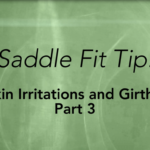The trapezius, the rhomboids and the spinales muscles all converge in your horse’s wither area. One could liken the withers area to a distributor cap since it contains these muscle groups and also nerve endings as well as the convergence of the nuchal and dorsal ligament systems. If the saddle puts pressure on this area because it is too tight in the tree, the horse will suffer significant pain. It will respond with a ‘flight response’ contracting his muscles in preparation for running away (or trying to). This is known as tensing up.
The shoulders of the horse easily change their position (no supporting collarbones); they move the same in every gait – up, back down forward. The shoulder blade is constantly moving toward the saddle’s position. The more extension in the forward-and-upward movement of the legs, the bigger the forward- and-backward movement in the shoulder. When the saddle is positioned directly behind the horse’s shoulder as the horse is standing still, there needs to be room enough for the shoulder to move through and under the tree points (the gullet plate needs to accommodate this movement along its entire length all the way to the end of the tree points) during motion. The shoulder blade has an elastic cartilaginous 3-4” cap at its top end, which can be easily damaged when the tree points are too tight or constantly hitting it. When this occurs, the muscle fibers surrounding the shoulder blade will also be impacted resulting in extreme pain for the horse, to the point of lameness. To avoid this, the saddle needs to be fitted properly with an adjustable saddle tree so that the tree’s width and angle accommodate the horse and allow his shoulder to “slip through” (like a sliding door).
 A symmetrical gullet plate (the steel arch under the pommel) may cause problems because it does not accommodate the natural unevenness of horses.
A symmetrical gullet plate (the steel arch under the pommel) may cause problems because it does not accommodate the natural unevenness of horses.Try this experiment to feel the range of motion of your horse’s shoulder blade. Have someone lead you while you are riding bareback. Lay your hands beside the withers, left and right. If you feel safe and balanced, close your eyes. You will feel the movement of the muscles here even at the walk. You will feel the contractions as well as movement of the shoulder cartilage rotating up and back. Now move your hands about 3-4 inches lower down – still behind the shoulder blades. During movement, the shoulder blades should glide smoothly through your hands (as long as the horse’s longissimus muscle is not in a state of contraction).
 This gullet plate has been opened wider on the left to ensure there’s enough room for a horse with a bigger left shoulder.
This gullet plate has been opened wider on the left to ensure there’s enough room for a horse with a bigger left shoulder.Often you find white hairs of the left side of the horse’s withers, which indicate the gullet plate is too tight and incorrectly fitted, or tree points that are too tight, incorrectly angled, or forward facing. A symmetrical gullet plate (the steel arch under the pommel) may cause problems if it cannot accommodate the natural unevenness of horses. Your best advice is to consult with a certified professional saddle fitter with expertise in fitting the saddle to allow shoulder freedom for the horse in motion.
 Most often, you will find white hairs on the left side of the horse’s withers, which indicate a gullet plate that was too tight and incorrectly fitted, and tree points that were also too tight, incorrectly angled, or forward-facing.
Most often, you will find white hairs on the left side of the horse’s withers, which indicate a gullet plate that was too tight and incorrectly fitted, and tree points that were also too tight, incorrectly angled, or forward-facing.Author of ‘Suffering in Silence – The Saddle fit Link to Physical and Psychological Trauma in Horses’ (2013) Jochen Schleese teaches riders and professionals to recognize saddle fit issues in Saddlefit 4 Life lectures and seminars. We help you find answers in a personal 80 point Saddle Fit Diagnostic Evaluation.
www.SaddlesforWomen.comand Guys too! 1-800-225-2242 www.Saddlefit4life.com







